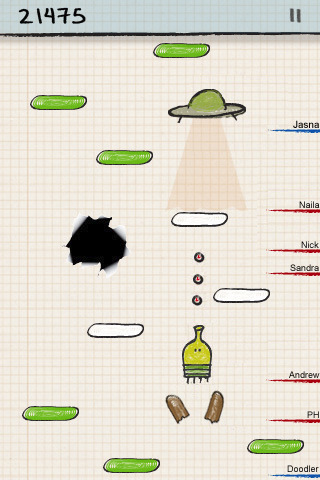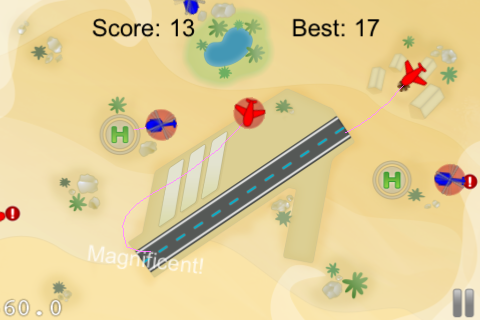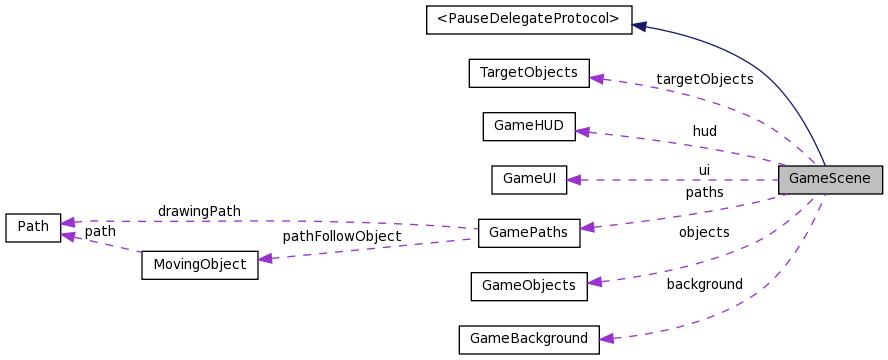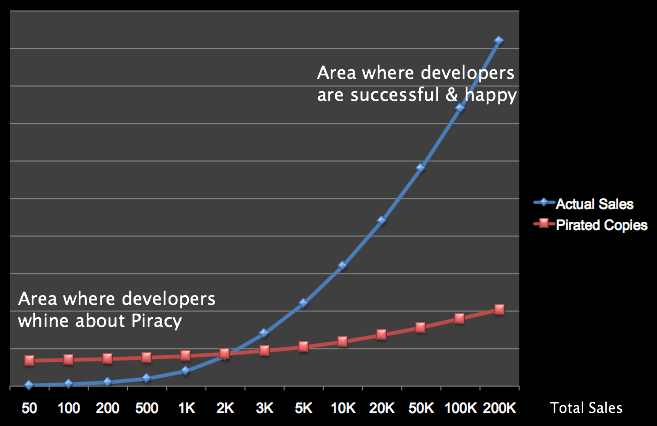You may have heard about the Appvent Calendar by Blacksmith Games, creators of Floop and Plushed. From that idea emerged the popular Free App A Day website.
I thought, maybe I can take this idea and transform it into something slightly different: the Cocos2D Linkvent Calendar 2010. The idea being that I publish a blog post every day in December 2010 - you know, the month that ends after 24 days in that culminating event that will crash the App Store and end humanity’s existence. Or so I’ve heard. Each blog post will link to your website, blog post, tutorial, product, open source project or whatever else that might be of interest specifically to Cocos2D for iPhone developers, as long as it is “your thing”.
As my blog is closing in on 5,000 visits a week and my Twitter account is followed by over 1,400 hummingbirds and more and more of my book readers will come here and check out the site, I think that would be a nice gift to anyone who is interested in receiving some traffic from me. What you do to deserve a link is up to you. This is your chance to make your blog better known, or even kickstart it. The better and more relevant the content is to Cocos2D developers, the better your chances are that some of this traffic will stick, in form of return visits.
What you can do
Just to give you a few ideas:
- write a postmortem of your game, and your game will surely get a few extra sales as well
- open source your previous game’s source code, and in turn announce your new project
- lower the price of your commercial product on that day
- receive more attention for your technical essay about some aspect(s) of Cocos2D
- write an awesome tutorial, for example about integrating UIKit controls in a Cocos2D project
The only thing that’s important is that the article, website, product, game, etc. is somehow relevant and of interest to Cocos2D developers. So if you “only” have a game made with Cocos2D, you should spice that up by, for example, talking about your development experience or explaining how you solved some tricky aspects of the game’s source code, including examples.
Accepting Offers Now!
I’m accepting offers now and until all 24 slots are filled, while holding a few reserve slots just in case. Please send all link requests by email to linkvent (at) learn-cocos2d.com - you don’t want to spoil the fun by posting it as a comment!
Also, you can reserve a slot by letting me know what you have in mind and are going to do, without actually having to have something to link to right now. You should be able to prepare and publish your content by early to mid December though.
I probably can’t answer all request, but if I do include yours then you’ll get a notice when I’ll publish it. Keep in mind that I will publish posts on midnight Central European Time (CET) (UTC+1), so you may have to factor in time zone differences.
Note: this is all about helping individual developers and products receive the attention they deserve while giving Cocos2D developers some useful information to digest. For that reason, I won’t link to posts on forums, wikis or other aggregating sites, to Apps on iTunes or to a code repository with just some files in it. There ought to be something to read, a little guidance if you will, and it should come from you, and it should be connected to you by putting that up on your blog or website. You can then of course link from your post to wherever you like.
I’m pleased to announce that the Line-Drawing Game Starterkit is finally available for sale! It’s a source code project for anyone interested in developing a line-drawing game. The gameplay is modelled after the famous Flight Control game. The Starterkit works with the latest cocos2d v0.99.4 version and will at the very least receive compatibility upgrades for future cocos2d versions.
Hop on over to the product page to check out the feature list, the API documentation and a source code sample. You can also download the Starterkit App for iPhone from iTunes. The iPad Edition is still in approval.
Note: for the reminder of July 2010 you can get the Starterkit at an introductory price for only $179!
Positioning of the Starterkit
I’m sorry that you’ve had to wait one and a half months compared to the initially planned release date of June 1st. I double and triple checked every decision I made and you can see some of the results on the Starterkit product page.
I’ve also decided to increase the regular price from the initially intended $199 to $299 effective from August 1st, 2010. One of the reasons being that I initially planned to have multiple licenses including Indie and Commercial ones. I thought long and hard about positioning the Starterkit and eventually decided to sell only Site Licenses. For the individual developer it costs a bit more but for small and commercial teams it’s great news, and small teams and established, dedicated developers is who I am targeting. Those who really appreciate the value of commercial source code saving days and weeks of research and development, and all the trouble, sweat and pain associated with it. And I’m here to help if you have any questions regarding the Starterkit’s source code.
I don’t have plans to make another Starterkit and in all likelihood it will remain the only commercial cocos2d-related product for the remainder of this year.
Book Chapter about Line-Drawing Games
For those who are disappointed about the new price, either grab the Starterkit before August 1st or wait until December for the Learn iPhone and iPad Cocos2D Game Development book I’m writing. It will contain a chapter covering some of the basic aspects of a line-drawing game but without the finer details and complex interactions conveyed in the Starterkit. It’ll be Chapter 12 so in about 8 weeks (Mid-September) I’ll mention it in my weekly book chapter posts.
Closed Sales Period, Summary of
And here’s for transparency: exactly 10 days ago I informed the 668 subscribers of my Newsletter of the closed sales period. The password-protected Starterkit product page received just over 200 unique visitors. During the last 10 days I made 9 sales amounting to about $1,530 with Plimus’ 5% fee already deducted but obviously before tax. All sales were made within the first 4 days after I sent the Newsletter and for the last 6 days sales were absolutely zero. Although I’ve been in contact with several interested parties who didn’t want to or simply couldn’t buy it right now for various reasons. If you’re one of them: you’ll get it for $179 no matter when you make the purchase, just contact me beforehand.
Right now I’m curious to see how sales will be now that the Starterkit is publicly available.
Starterkit Promotion
I’d appreciate if you would tweet and re-tweet this post and mention the Starterkit to all fellow cocos2d-sians! If you would even go so far as writing a serious and honest review on your blog, please get in touch with me.
Just don’t test the waters by mentioning the Starterkit in the cocos2d community forum.
Stance Lance
I wish Ricardo had taken the time to be considerate and then talked to me instead of running off making an assumptive, excessive, and for the most part irrelevant (off-topic) stance post which only served to cause a big commotion among his community while allowing his forum rule “Treat people with respect.” to become a farce.
In Conclusion
In hindsight I’m glad that the whole thing got me thinking in so many new directions. Most importantly it got me in contact with a lot of developers who consciously don’t post on the cocos2d forum. To get those encouraging words and positive feedback and gaining interesting insights from other developer’s perspectives - especially those who tag along silently - really helped me understand the cocos2d development community better. Thank you, you know who you are!
The whole shebang also served as a great motivational factor to pour my everything into the cocos2d book, which came at just the right time to let off steam in just the right way. I’m writing it to be the cocos2d documentation it deserves and the one I always wished it had. I can’t even begin to describe how satisfying it feels to write this book. So much in fact that it hurts to stop writing every time I reach the 27 pages each chapter is expected to have. 
WOS Blog has a post online which really sums up well how i look at the App Store:
“Don’t believe anyone who whines that it’s hard to make money with a really good game on the App Store, viewers. They’re either lying, or imbeciles, or both.”
It’s called How not to do it and covers some basis of why certain Apps succeed while others fall by the wayside. Sometimes it’s a matter of beating someone to the market, other times to learn from other’s mistakes, but mostly to price your Apps fairly.
A while ago i read about Indie game developers who eventually thought it would be a good idea to spend 3-6 months on their next game, to sell the App by means of quality and content. While there are chances that this will work and even reward you greatly money-wise, it also increases your risks by several factors. You’re going down the same path that leads to similar problems of the AAA game developers, albeit on a much smaller scale. It’s a hit-driven business. If you did moderately well on your 1-2 month games, and then you do a 3-6 month game, your chances of making it a success get slimmer and slimmer. It does help to understand the market and marketing but even that won’t help you if the game doesn’t vibe with players.
So, would you rather have a less than 50% chance of making it (relatively) big, or a 100% chance of doing moderately well?
Of course, if you can keep running the 100% part of your business you should really consider making the bet. But if you have no money to spare you should stick with moderately well and instead keep pumping out moderately well doing games. Make 8 of those over the year and you got yourself a respectable business nonetheless.
I wonder what happened to those Indies and their “big project”? Hmmm …
On May 27th, the whole world saw the future. Because i told you so!
Line-Drawing Game Starterkit -> June 1st!
What’s that you ask?
It is the ideal starting point for your own Line-Drawing game! (like Flight Control and Harbor Master) It is a cocos2d source code project that will be available for sale. But not sight unseen, no. It will appear on the App Store for you to try out. And you get more, the full doxygen-generated source code documentation is available for browsing right now! Just so that you can assess the scope of the project.
What will it cost?
I admit i haven’t decided on that yet.
Show me your license!
Alright, alright. I’ll be fair: Free lifetime upgrades! Unlimited number of developers!
Each license is good for one published game. Additional licenses for follow-up games come at a discount. “Lite” versions do not require an extra license since they are essentially the same game. There will also be a commercial license for developers or studios who make more than $6,000 per month in revenue and can easily afford a higher price.
Why, please tell me why?
Because i can. I like technology and i like programming games. I’m also an enabler and i would love to see others build something unique based on game development technology i provide.
Anything else?
Yes. Today sees the premature end of the best new show of last year. RIP Flash Forward.
If you think your game suffers tremendeously from App Store Piracy, you’re wrong. To put it bluntly: your game has simply failed on the market!
Reports that put the App Store piracy rates at “at least 60%” and developers reporting piracy rates of 80% and even up to 95% are mathematically correct but what they often forget to tell you are actual sales numbers. In the rare cases where Indie developers also mention how many sales they have made, pirates or not, these numbers are always extremely low. For a commercial developer who reports an 80% piracy rate on one of his games it’s simply an attempt to turn terrible sales into a PR story which might give their game a little bit more attention. In fact, i expect the games who report piracy rates of over 30% to have sold no more than 5,000 copies. At $.99 this creates a revenue of $3,500 - maybe a good number for a two-man team but a catastrophe for a commercial developer. This is hardly a problem caused by piracy but a simple failure of the product on the market.
What you have to understand about Software Pirates in general: they use a lot of software. In fact, this is their hobby and favorite passtime, to try out as much software as they can get their hands on. So you will always have a minimum amount of pirated copies of each piece of software, no matter how successful this software is (or not). Of course, with higher success and more sales of the software more pirates are also likely to use it because they, too, value quality software. But given the amount of jailbroken iPhone devices prepared to run pirated software there’s a hard cap of the maximum amount of piracy you will ever see on any title. Just as much as there will be a minimum number of pirates playing every game as soon as it becomes available and regardless of how successful it is on the App Store. If your sales are close or below that minimum number of pirates, you naturally get piracy rates of over 50%. These pirates don’t cut into your revenue however. Ignore them. They never would have bought your App in the first place!

David Rosen from Wolfire reports in his Another View on Piracy article that the highest number of Jailbroken iPhones worldwide is said to be 10%, and in the USA - whose users constitute about two thirds of the iPhone/iPod market - the number of jailbroken devices is just 5%. Assuming a total installed base of 75 Million iPhones (50 Mio. as of April 2010) and iPod touches (20 Mio. as of Sept. 2009) we get at most 7.5 Mio jailbroken devices worldwide, or approximately 2.5 Mio jailbroken devices in the USA. They are not all pirates, however. PinchMedia reports that 38% of jailbroken devices have run at least one pirated App. They also state this number is low. So let’s just take half and we’ll end up with 3.75 Mio. jailbroken devices worldwide which have run at least one pirated App. Still a pretty high number - but it only tells us that they have started one pirated App but not how many or how much of a pirate these users really are. If i had to guess i would say that 10% or just about 400,000 of these users are active pirates who try out a lot of Apps on an almost daily basis. These are the pirates who make the biggest impact in terms of per-App piracy numbers. They are also the users who are least likely to upgrade their pirated copy to a legal one, if they ever do it at all. And trying to fight these pirates is anything but futile - they will never be your customers!
PinchMedia also supports my theory that most Pirates try out as much Software as they can which, of course, leaves less time to use each App intensely: “Pirated applications are used less frequently, less intensely, and for a shorter overall length of time than purchased applications.”
Let’s go back to the gist of it: developers who have a problem with App Store Piracy have, in my opinion, either a problem of perception or they’re making a simple PR statement aimed at getting them more attention, hoping to achieve better sales. The developers who suffer most from App Store Piracy are those who simply are not successful. Their real problem isn’t Piracy, it’s much more likely that they failed either at Marketing, Timing, Quality or finding their Target Audience.
Let me sum this up with a simple chart which i think explains why App Store developers report amazingly high piracy rates, when in fact they are reporting the commercial failure of their App:
This one should be obvious: making games is hard.
What’s not so obvious: making simple games is still hard.
Ever heard someone proclaim “Oh, i could make that in a day!” after having glanced at yet another simple game that’s all the rave on the App Store? I bet you did. Truth is: they’re almost always wrong. Even if it’s someone who has years of experience programming games.
You know Jamie from Mythbusters is saying in their disclaimer shots: “It may not look like it, but we’re professionals”. Well, the Mythbusters are professionals. Who is to say you can’t fool around like a child and still be professional? It’s much like your regular game development team. Anyway, did you ever notice how surprised they often are about their results? Or how much work it would be to get their myths tested? Same goes for game developers.
A game programmer who is sure he can do that game in a day just by looking at it is a lot like your typical Mythbuster, or Mythbuster viewer, who thinks they know the outcome before the test - and then they’re in for a surprise. Sure sometimes they’ll be largely correct. Yes you can shoot a ball at 60 mph in the opposite direction of a car going 60 mph and the ball will just drop down straight to the ground. That is just simple physics. Even i knew that. I also know how to make games. And i can vividly imagine how many more tests and excrutiating amounts of work went into confirming that myth. The same amount of excrutiating work and detailed adjustment go into making any game as well. But they don’t show that on your screen, do they?
Game programmers who can actually make a complete game in a day are a myth. Once you’ve done a couple games you know that. And once you hear someone proclaim they can do it in a day, please take them by their word and put them to the test!
Let’s take Doodle Jump as an example. It’s been a target for ridicule from quite some game programmers who just couldn’t stand that something as simple (and stupid as they say) can be so successful. Could you do it in a day? Could you even do it in a week? Let’s put it to the test!
How?
Simple, we’ll just make a feature list and you can answer the question yourself: how long will it take to complete this? Please post in a comment how long you think it would take to complete all this, assuming you had all the graphics and sounds.

- Menu
- Challenge by Email
- Highscores Screen: Local, Facebook Friends and Global (Webserver connection)
- Options Screen, various options
- Connect & Submit Score to Facebook (Facebook API)
- Connect & Submit Score to Twitter (Twitter API)
- Change your name
- Pause Screen
- Game
- Player jumping
- Accelerometer controls
- Wrap Player when leaving either screen side
- Player shooting on tap
- Scrolling Game Objects as Player goes up
- Scroll in Menu on game over
- 7 different Platform Types, one that can be moved by touching it
- 6 Enemies and 1 or 2 Boss Monsters
- UFOs and Black Holes
- 6 Powerups: Springs, Jetpack, etc.
- Display Friend Scores on the side
- Score display
- Stuff that people often forget to think of
- randomly generate platforms in a meaningful way with progressing difficulty and no unfair situations
- cheats and easter eggs (not mandatory but Doodle Jump has a lot!)
- several themes with all new graphics
Did i forget anything? Probably. Usually when you make feature lists like this you get 80%, maybe 90% of all features of you’re really thorough. There’s always something you’ll forget when you look at a game’s features, and there’s even more you’ll forget when you plan the game. Unless you plan for “When it’s done.” - which more often than not means: never. Or Duke Nukem Forever. Same thing really.
I stumbled across this AppBoy Blog Post about Android and its Market. And it reminded me of what i think when i hear people swearing by the Android: the Android is not going to rule the world. Period.
The reasons are not many but they are crucial. First, Open Source is not a Feature! I hear that very often. “Yeah but Android is Open Source, you can’t compete with that!”. Uh-huh. As a matter of fact, i do not want to compete with Open Source if that means low-quality crap. There is no quality control on the Android Market. For some this spells freedom of choice and what not. And yes, Apple has made some decisions to pull apps from the App Store that a lot of people didn’t like. But let’s not forget that 99% of iPhone OS users just don’t care. There’s still enough diversity, and it’s not like Apple has pulled the Facebook App, Twitterific, Doodle Jump or Angry Birds. Apps that people really use and like. Keep in mind that whenever Apple decides to pull an App, recently that was because of mature content while allowing a big player in that market to keep his Apps online, people talk about that because (a) they like to get upset and (b) the blogosphere and news outlets need something to talk about. In the end it’s just hot air.
Let’s get back to Android though. So it’s open source. What does that even mean? The OS itself is open source. Great for the companies who build their own devices on that software. Bad for the consumer: you still have the same problem all mobile phones have. It’s like switching from Nokia and it’s hundreds of different devices united by the Ovi Store to Android, with its hundred and more and more diverging devices and a united App Store. Where does that lead us? A huge pile of free choice no one really wants if you so will. For developers it gets increasingly harder to develop Apps that run on all Android devices and what’s more, even if you manage to support 99% of all devices right now, tomorrow there will be a new device coming out that won’t run your app. As an independent developer this is hell. You have no way of telling whether supporting a specific line of Android devices will get you a significant sales boost. So how do you calculate how much time you’ll spend on each? It’s pure guesswork. I pity Android developers.
The iPhone market itself is hard but there’s one thing you can and should put all your efforts in: Marketing. You develop for one device (well, ok make that 3) while in the meantime you figure out which websites to target, what to blog, which communities to join, where to apply for App reviews, what Press Releases to send out, etc. The code is already done, Marketing your App is the hard part. It’s the same with the Android, except that the code part with its diverging devices is just as hard to do. And it’s just not fun adapting the same app to different devices. It’s one of the things i wouldn’t mind not doing.
Most of the outspoken people who choose Android choose it because they don’t like Apple (fair enough), or they don’t like closed ecosystems and enjoy (really?) everything that has the label “Open Source” attached to it. However, they’re a minority on the Android market. Most Android users just got what they needed: a working mobile phone. They have no idea, and no clue and don’t care about Open Source. For them, the label “Open Source” has no meaning.















